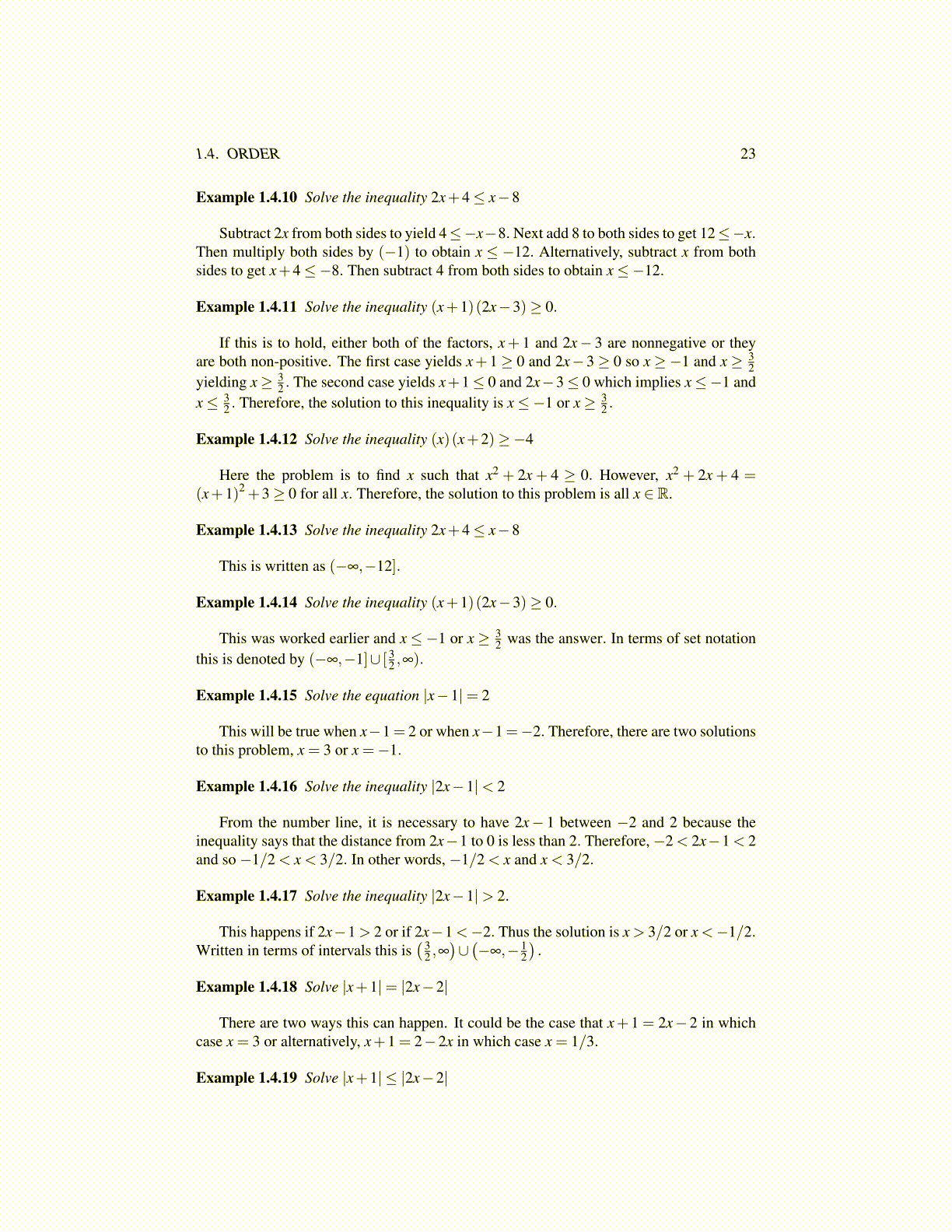
1.4. ORDER 23
Example 1.4.10 Solve the inequality 2x+4 ≤ x−8
Subtract 2x from both sides to yield 4≤−x−8. Next add 8 to both sides to get 12≤−x.Then multiply both sides by (−1) to obtain x ≤ −12. Alternatively, subtract x from bothsides to get x+4 ≤−8. Then subtract 4 from both sides to obtain x ≤−12.
Example 1.4.11 Solve the inequality (x+1)(2x−3)≥ 0.
If this is to hold, either both of the factors, x+ 1 and 2x− 3 are nonnegative or theyare both non-positive. The first case yields x+1 ≥ 0 and 2x−3 ≥ 0 so x ≥−1 and x ≥ 3
2yielding x ≥ 3
2 . The second case yields x+1 ≤ 0 and 2x−3 ≤ 0 which implies x ≤−1 andx ≤ 3
2 . Therefore, the solution to this inequality is x ≤−1 or x ≥ 32 .
Example 1.4.12 Solve the inequality (x)(x+2)≥−4
Here the problem is to find x such that x2 + 2x + 4 ≥ 0. However, x2 + 2x + 4 =(x+1)2 +3 ≥ 0 for all x. Therefore, the solution to this problem is all x ∈ R.
Example 1.4.13 Solve the inequality 2x+4 ≤ x−8
This is written as (−∞,−12].
Example 1.4.14 Solve the inequality (x+1)(2x−3)≥ 0.
This was worked earlier and x ≤ −1 or x ≥ 32 was the answer. In terms of set notation
this is denoted by (−∞,−1]∪ [ 32 ,∞).
Example 1.4.15 Solve the equation |x−1|= 2
This will be true when x−1 = 2 or when x−1 =−2. Therefore, there are two solutionsto this problem, x = 3 or x =−1.
Example 1.4.16 Solve the inequality |2x−1|< 2
From the number line, it is necessary to have 2x− 1 between −2 and 2 because theinequality says that the distance from 2x−1 to 0 is less than 2. Therefore, −2 < 2x−1 < 2and so −1/2 < x < 3/2. In other words, −1/2 < x and x < 3/2.
Example 1.4.17 Solve the inequality |2x−1|> 2.
This happens if 2x−1 > 2 or if 2x−1 <−2. Thus the solution is x > 3/2 or x <−1/2.Written in terms of intervals this is
( 32 ,∞
)∪(−∞,− 1
2
).
Example 1.4.18 Solve |x+1|= |2x−2|
There are two ways this can happen. It could be the case that x+1 = 2x−2 in whichcase x = 3 or alternatively, x+1 = 2−2x in which case x = 1/3.
Example 1.4.19 Solve |x+1| ≤ |2x−2|